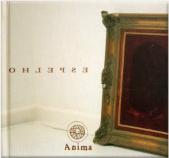

Epilogue
“In ESPELHO, his fourth CD, the ANIMA Group shows ... the
mutual reflections between musical repertoires of the old
European music, especially those of modal language and the music
of Brazilian oral tradition. Here, however, some of the themes
of the songs participate in this specular game ... the
interpretation of the ANIMA is what makes MIRROR reflect in such
a striking and clear way to our present ears this music of
origins, produced by an ancestral man . A song that already
carries in itself a special power to reflect the world, sharing
the same properties of the optical instrument”.
(FCD bibl. 4)
"Mirror, from the ancients, is an attribute of Wisdom, but
Carnality also holds it in the hands; nor need I say that it is
a Virtue and an Addiction. " (FCD bibl. 4)
MIRROR is a musical allegory that assumes that music is also
a powerful mirror capable of reflecting cultures and distant
worlds, messages written long ago and captured today - reflected
by their interpreters - not faithfully, but with loyalty and
also distortions, the rust of time, the filter of cultures and
the impurities of one, among the infinite possible
interpretations of the past, in the present. We knew,
beforehand, that it was impossible to deal with the dimension of
a theme of this depth - for example, in the Muslim mystic, the
mirror constitutes the very symbol of symbolism. Nor would it be
our intention, mere "practical" musicians that we are. As such,
we share the principle that music is made from the
"concreteness" of sounds - considering that it is only a
"half-truth", or rather a third of truth. Contradictingly,
however, the sea of creation, a symbol of creative freedom
itself, has created the need for security anchors, or rather,
support points for the organization of "chaos."
The first point of organization, or support, is the very poetics
of anonymous artists, spread over time and mirrored in
contemporary Brazil, engendering art that overpowers the
material poverty of potential victims of all forgetfulness. This
man, originated in an anonymous, illiterate culture that conveys
his art and knowledge through orality, is an example of a great
set of mirrors, reflecting knowledge from generation to
generation, with multiple looks generated by the porosity of
borders and memory
A second point of support will be, as a consequence, the work
done by researchers and musicologists who patiently recorded, in
their journeys and collections, immense musical material, making
it available to future interpreters like us. In this context,
reverence is always the figure of Mário de Andrade. Not least,
we also support a great deal of ANIMA's work over those of
artists who, at different times and places, both renowned
luthiers and anonymous craftsmen have made our musical
instruments - our guides from which, by an initially blinded
path , we constructed a musical architecture supported by the
very diversity of origin of these same instruments.
Another important issue for us is the "reflection" about the
musical performance on the stage, the musical performance.
This is a relatively new issue in the art of sounds, especially
in the question of the transposition of musical practices linked
to rituals (boi-bumbá, reisados, songs of devotion or linked to
some liturgy, medieval dances, etc.) for the environment of
concert, molded to receive more appropriately the "pure music"
than a "hybrid music". Here too the mirror offers us a beautiful
metaphor, as Fernando Carvalhaes has shown us: "this musical
piece reflects in a special way the world to which it opens,
because the listener in it also recognizes itself, acting in
each listening. We, the spectators - listeners of a musical
interpretation - are, in turn, a mirror for the portrait - a
work of art reflecting reality, lending it sensibility and
meaning". (FCD, 4). After fifteen years treading this path,
we realized that the transforming moment of the stage should not
be imposed on us as a closed question, but on the contrary,
susceptible to diverse readings, just as are arrangements and
compositions written for or by the group. To do so, we seek help
from other glances sensitive to such realities and we find in
LUME Theater, in the scenic direction of Jesser de Souza and
Raquel Scotti Hirson, a warm welcome that helps us to take this
music to the stage also as a scenic language.
In MIRROR we especially counted on the fundamental
participation of the medievalist, musicologist, composer,
arranger, singer and friend Fernando Carvalhaes Duarte, who
elaborated three arrangements especially for this project, and
guided us by lending his musical sensitivity with invaluable
exchanges of correspondence, essays and advice on
interpretation. We dedicate this work to him in memoriam.
SPECULUM MUNDI (encyclopedia)
“Etymologically it comes from Speculum that
gave name to speculation: originally, to speculate was to
observe the sky and the relative movements of the stars, with
the aid of a mirror. In Muslim mysticism it is considered the
very symbol of symbolism. The Neoplatonic notion of the two
faces of the soul, which would have a lower side, facing the
body and an upper side, turned to intelligence exerted a great
influence among the Sufis. Attar says that the body is in its
obscurity as well as the back of the mirror; the soul is the
clear side of the mirror. About these two faces of the mirror,
Rumi explains that God created this world, which is obscurity,
so that its light could manifest itself. Similarly, according to
the theory of the microcosm as an image of the macrocosm, man
and the universe are in the respective positions of two mirrors.
In the same way individual essences are reflected in the divine
Being, according to Ibn'Arabi, and the divine Being is reflected
in the individual essences. Being the heart symbolized by a
mirror - of metal, formerly -, the rust symbolizes the sin and
the polishing of the mirror, its purification.” (DS bibl.
5, p. 393;396)
According to medieval symbology, this polarity
is represented by the "Mirror of Nature, which reveals to man
his soul, according to a perfect truth. In the other source ...
nothing is stable. It is a dangerous mirror ... No man can
recognize his face in the dark waters ... this is the source
that killed Narcissus: when one looks at its waters it does not
see its soul, but simply the body, a transient image that it
takes for its true self". (CDF 4)
"The celestial intelligence reflected by the
mirror symbolically identifies itself with the Sun: this is why
the mirror is often a solar symbol. But it is at the same time a
lunar symbol, in the sense that the Moon, like a mirror,
reflects the light of the Sun. The Wisdom of the great Mirror of
Tibetan Buddhism teaches the supreme secret, namely, that the
world of the forms which in it reflection is nothing but an
aspect of shunyata, the vacuum. "(DSB, 5, p.394). In this
regard, Guimarães Rosa, in the short story "The Mirror", has a
permanent dialogue between the transcendent world of the mirror
and the real world: "You, for example, who knows and studies,
I suppose, and has no idea what it really is - a mirror?
Moreover, of course, the notions of physics, with which he
became familiar, the laws of optics. I refer to the
transcendent. All, by the way, is the tip of a mystery. In fact,
the facts. Or their absence. Doubt? When nothing happens, there
is a miracle that we are not seeing." (ROSA, 1988, 65). As a
reversal of enlightenment, the obscure face of the mirror is
mentioned in this passage from Grande Sertão: Veredas: "I no
longer thought of the whirlwind of wind, nor of the owner of it
- which is said - dwelling within, who travels, the Dirty: what
accepts the bad words and thoughts of the people, and that
completes everything in the work; what we can see on a black
mirror sheet; the Concealer".(ROSA, pp. 243-244, apud
ARROYO, 1984, 148). Was he saying that Good and Evil are side by
side within us?
Research Fonts / Bibliography
ALVARENGA, Oneyda – Melodias registradas por meios
não-mecânicos, São Paulo, Arquivo Folclórico da
Discoteca Pública Municipal, 1946.
ANDRADE, Mário – Os Cocos: preparação,
ilustração e notas de Oneyda Alvarenga, São Paulo, Ed. Duas
Cidades, 1984.
ARROYO, Leonardo – A Cultura popular em
Grande sertão: Veredas, Rio de Janeiro, Ed. J. Olympio,
1984.
DUARTE Fernando J. Carvalhaes – Sobre
Jogos e Júbilos: o percurso de uma invocação, in Arte e
Cultura IV Estudos Interdisciplinares, São Paulo, Ed.
Annablume, 2006.
GÓMEZ, M. Carmen – El Llibre Vermell
de Montserrat. Cantos y Danzas s. XIV, Barcelona, Los
Libros de la Frontera,1990.
NÓBREGA, Ana Cristina P. – A rabeca
no cavalo marinho de Bayeux, Paraíba, Ed. UFPB, 2000.
RIBEIRO, M. de Lourdes Borges –
Moçambique, Cadernos de Folclore, Rio de Janeiro,
Funarte,1981.
ROSA, João Guimarães: A terceira margem do
rio, in: Primeiras estórias, Rio de Janeiro, Ed. N.
Fronteira, 1988 p. 32;32;35.
_________, O Espelho, in: op. cit, p.
65.
PINTO, Benedita C. - Nas Veredas da
Sobrevivência: Memória, gênero e símbolo de poder feminino em
povoados amazônicos, Belém, Ed. Paka-Tatu, 2004.
(1) Manuscrito Paris fr. 847 Biblioteca Nacional
(2) Manuscrito London BM add 29987
(3) Graduale Triplex, 34 ,
Abadia de Silos, Burgos, Espanha
(4) FCD: fragmentos de textos escritos
por Fernando C. Duarte para o Grupo ANIMA, julho de 2006.
(5) DS: Dicionário de Símbolos
– J. Chevalier, A. Gheerbrant, Rio de Janeiro, Ed. José Olympio,
1982.
Discography
- Famaliá Sons do Urucuia - coleção Documentos
Sonoros Brasileiros-acervo Cachuêra! Itaú
Cultural, vol. 4.
- Llibre Vermell de Montserrat – Cantigas de Santa Maria
– Alla Francesca, voix et instruments du Moyen Age,
Paris, selo Opus 11, 1995.
- La musique dês Troubadours – Clemencic Consort –
Itália, selo Harmonia mundi, 1977/ 1998.
- Música popular do centro-oeste/sudeste vol. 2,
São Paulo – Discos Marcus Pereira, 1974.
- Bumbarqueira – Programa Raízes, Cametá, Pará,
Fundação Curro Velho, 2005.
- Música popular do centro-oeste/sudeste vol. 1,
São Paulo, Discos Marcus Pereira, 1974.
- Chominciamento di gioia: Virtuoso dance-music from the
time of Boccaccio´s Decamerone - Ensemble Unicorn,
Vienna, selo Naxos, 1994.
- Cavalo Marinho da Paraíba, Brasil- série “a
viagem dos sons”, Lisboa, selo Tradisom, 1998.
- Alegrementes Cantano: Terno de Reis de Vitória da
Conquista, Bahia, selo independente, 2004.






